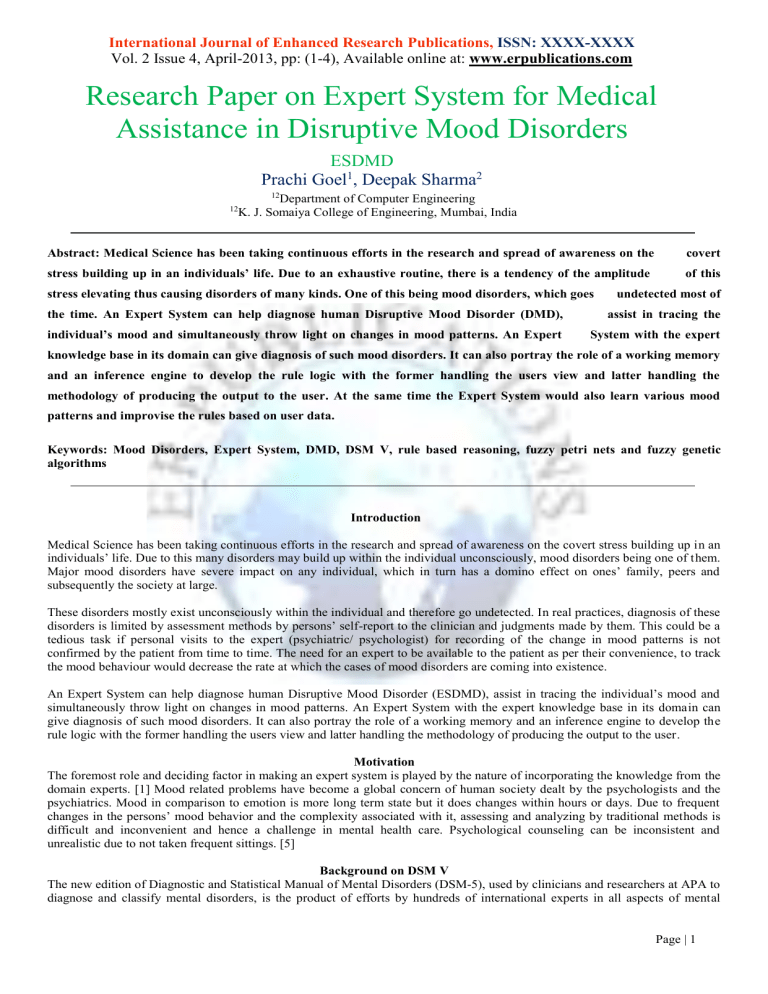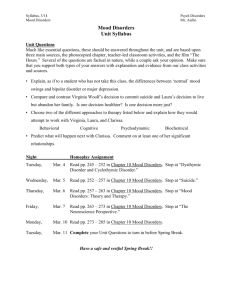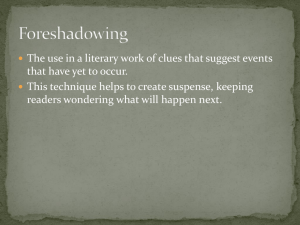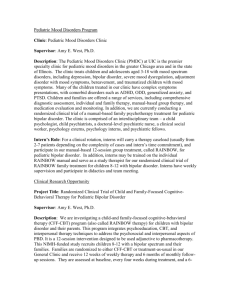Paper Title (use style: paper title)

International Journal of Enhanced Research Publications, ISSN: XXXX-XXXX
Vol. 2 Issue 4, April-2013, pp: (1-4), Available online at: www.erpublications.com
Research Paper on Expert System for Medical
Assistance in Disruptive Mood Disorders
ESDMD
Prachi Goel
1
, Deepak Sharma
2
12 Department of Computer Engineering
12 K. J. Somaiya College of Engineering, Mumbai, India
Abstract: Medical Science has been taking continuous efforts in the research and spread of awareness on the covert stress building up in an individuals’ life. Due to an exhaustive routine, there is a tendency of the amplitude of this stress elevating thus causing disorders of many kinds. One of this being mood disorders, which goes undetected most of the time. An Expert System can help diagnose human Disruptive Mood Disorder (DMD), assist in tracing the individual’s mood and simultaneously throw light on changes in mood patterns. An Expert System with the expert knowledge base in its domain can give diagnosis of such mood disorders. It can also portray the role of a working memory and an inference engine to develop the rule logic with the former handling the users view and latter handling the methodology of producing the output to the user. At the same time the Expert System would also learn various mood patterns and improvise the rules based on user data.
Keywords: Mood Disorders, Expert System, DMD, DSM V, rule based reasoning, fuzzy petri nets and fuzzy genetic algorithms
Introduction
Medical Science has been taking continuous efforts in the research and spread of awareness on the covert stress building up in an individuals’ life. Due to this many disorders may build up within the individual unconsciously, mood disorders being one of them.
Major mood disorders have severe impact on any individual, which in turn has a domino effect on ones’ family, peers and subsequently the society at large.
These disorders mostly exist unconsciously within the individual and therefore go undetected. In real practices, diagnosis of these disorders is limited by assessment methods by persons’ self-report to the clinician and judgments made by them. This could be a tedious task if personal visits to the expert (psychiatric/ psychologist) for recording of the change in mood patterns is not confirmed by the patient from time to time. The need for an expert to be available to the patient as per their convenience, to track the mood behaviour would decrease the rate at which the cases of mood disorders are coming into existence.
An Expert System can help diagnose human Disruptive Mood Disorder (ESDMD), assist in tracing the individual’s mood and simultaneously throw light on changes in mood patterns. An Expert System with the expert knowledge base in its domain can give diagnosis of such mood disorders. It can also portray the role of a working memory and an inference engine to develop the rule logic with the former handling the users view and latter handling the methodology of producing the output to the user.
Motivation
The foremost role and deciding factor in making an expert system is played by the nature of incorporating the knowledge from the domain experts. [1] Mood related problems have become a global concern of human society dealt by the psychologists and the psychiatrics. Mood in comparison to emotion is more long term state but it does changes within hours or days. Due to frequent changes in the persons’ mood behavior and the complexity associated with it, assessing and analyzing by traditional methods is difficult and inconvenient and hence a challenge in mental health care. Psychological counseling can be inconsistent and unrealistic due to not taken frequent sittings. [5]
Background on DSM V
The new edition of Diagnostic and Statistical Manual of Mental Disorders (DSM-5), used by clinicians and researchers at APA to diagnose and classify mental disorders, is the product of efforts by hundreds of international experts in all aspects of mental
Page | 1
International Journal of Enhanced Research Publications, ISSN: XXXX-XXXX
Vol. 2 Issue 4, April-2013, pp: (1-4), Available online at: www.erpublications.com
health. Their dedication and hard work have yielded an authoritative volume that defines and classifies mental disorders in order to improve diagnoses, treatment, and research. The criteria’ is concise and explicit, intended to facilitate an objective assessment of symptom presentations in a variety of clinical settings—inpatient, outpatient, partial hospital, consultation liaison, clinical, private practice, and primary care. New features and enhancements make DSM V easier to use across all settings. The Diagnostic and Statistical Manual of Mental Disorders, Fifth Edition, updated from the fourth edition [2], is the most comprehensive, current, and critical resource for clinical practice available to today's mental health clinicians and researchers of all orientations. The information contained in the manual is also valuable to other physicians and health professionals, including psychologists, counselors, nurses, occupational and rehabilitation therapists, as well as social workers and forensic and legal specialists. [25]
This DSM V was released by APA in May 2013 and it gives additional information about the Disruptive Mood Disorders.
Meaning of DMD
Mood disorders are among the most common diagnoses in psychiatry. Mood is a persistent emotional state as differentiated from affect, which is the external display of feelings. Disruptiveness caused by Mood Disorders causes disability to the person as addressed by World Health Organization. It has estimated as many as 121 million adults being affected by such mood disorders.
[19] There are three major categories of mood disorders according to the Diagnostic and Statistical Manual of Mental Disorders,
4th edition: unipolar mood disorders (major depressive disorder, dysthymic disorder), bipolar mood disorders (bipolar I disor der, bipolar II disorder, and cyclothymic disorder), and mood disorders having a known etiology (substance-induced mood disorder and mood disorder due to a general medical condition). [26]
Scope
Nowadays, web behavior plays a significant role in peoples’ life and mental health. It would be very fruitful if the detection of mood behavior is achieved over the web as many people may have access to the application thus synchronizing their personal work and aiding to inputs for their mental health. [8] It requires to carefully categorize the nature of people and gather the corresponding expert data which will help to formulate a pattern to recognize the variation in the mood analysis. ESDMD focusses on the diagnosis of the mood disorders within the defined standard of features provided for the patient detection of any variation of the mood disorder and allowing modification in rules.
Literature Survey
Following are the research papers and their outcomes which helped in the understanding of the system for the diagnosis of Mood
Disorders:
Ref
No
Research Paper/Author Observation/Methodology
[1] Annaiahshetty, K.; Prasad, N., "Expert System for
Multiple Domain Experts Knowledge Acquisition in
Software Design and Development," Computer
Modelling and Simulation (UKSim), 2013 UKSim 15th
International Conference on , vol., no., pp.196,201, 10-
12 April2013
Domain of the expertise knowledge required to build expert system.
JESS java based tool to incorporate multiple expert domains in one software.
[2]
[9]
[11]
[6]
"Wearable Monitoring for Mood Recognition in Bipolar
Disorder based on History-Dependent Long-Term Heart
Rate Variability Analysis,“
"Wearable monitoring systems for psychological and physiological state assessment in a naturalistic environment”
Moore, P.J.; Little, M.A.; McSharry, P.E.; Geddes, J.R.;
Goodwin, G.M., "Forecasting Depression in Bipolar
Disorder," Biomedical Engineering, IEEE Transactions on , vol.59, no.10,pp.2801,2807,Oct.2012
Advanced bio signal processing to recognize 4 mood states i.e. depression, mixed state, hypomania, mania
Using heart rate variability(HRV) upto 18hrs and challenging due to movement artifact rejection, comfort and power consumption.
Standard used was DSM IV criteria.
By use of Guassian process regression and the graph adapted to create sample points to analyze the mood diary of the patients.
GPR is a training set versus time indices graph to find the variation in the disorder.
Page | 2
[7]
[8]
[22]
[14]
International Journal of Enhanced Research Publications, ISSN: XXXX-XXXX
Vol. 2 Issue 4, April-2013, pp: (1-4), Available online at: www.erpublications.com
Masri, R.Y.; Jani, H.M., "Employing artificial intelligence techniques in Mental Health Diagnostic
Expert System," Computer & Information Science
(ICCIS), 2012 International Conference on , vol.1, no., pp.495,499, 12-14 June 2012
"Using decision tree to predict mental health status based on web behavior“
"Addressing Mental Health Epidemic Among
University Students via Web-based, Self-Screening, and
Referral System: A Preliminary Study"
Rule based reasoning for adaption in knowledge base creation of rules.
Fuzzy certainty factor for the threshold in genetic algorithms approach and finding possible optimized solution. This is preferred approach than analysing separately.[12]
Web behaviour can help to analyse the mood related symptoms and help to create positive mood.
Evaluation done based on the questionnaire and decision tree method used. No expert involved.
S No a. b.
Type of Disorder
Unipolar Disorder
[20] i.
Level 1 screening
Dysthymic Disorder ii.
Level 2 screening
Major Depressive Disorder
Bipolar Disorders i.
Level 1 Bipolar IIhypomania (a milder form of elevated mood than mania) ii.
Level 2 Bipolar I- at least one episode of mania iii.
Cyclothymic disorder is a recurrent, chronic, mild form of bipolar disorder in which mood typically oscillates between hypomania and dysthymia.
Types of Mood Disorders
Symptoms
Mood : depressed mood most of the day, nearly every day
Sleep : insomnia or hypersomnia
Interest : marked decrease in interest and pleasure in most activities
Guilt : feelings of worthlessness or inappropriate guilt
Energy : fatigue or low energy nearly every day
Concentration : decreased or increased indecisiveness
Appetite : increased or decreased appetite or weight gain or loss
Psychomotor : psychomotor agitation or retardation
Suicidality : recurrent thoughts of death, suicidal ideation, suicidal plan, suicide attempt
Self-esteem : highly inflated, grandiosity
Sleep : decreased need for sleep, rested after only a few hours
Speech : pressured
Thoughts : racing thoughts and flight of ideas
Attention : easy distractibility
Activity : increased goal-directed activity
Hedonism : high excess involvement in pleasurable activities (sex, spending, travel)
Criteria
General criteria for a major depressive episode require five or more of the above symptoms to be present for at least 2 weeks; one symptom must be depressed mood or loss of interest or pleasure.
General criteria for a manic episode require a clear period of persistently elevated, expansive, or irritable mood lasting 1 week or severe enough to require hospitalization.
Three to four of the criteria are required during the elevated mood period.
Page | 3
S No c.
International Journal of Enhanced Research Publications, ISSN: XXXX-XXXX
Vol. 2 Issue 4, April-2013, pp: (1-4), Available online at: www.erpublications.com
Type of Disorder
Substance Abused
Substance-induced mood disorder is diagnosed when medications, other psychoactive substances or phototherapy are proximate events and the likely cause of the mood disturbance.
Symptoms
Intake of any substance which is not recommended by specialist.
Criteria
To ensure non recommended medicines are not taken by patient
Proposed System
The proposed system can be represented with the following block diagram:
Fig: Proposed Model for ESDMD
The various entities in ESDMD are: a.
User Interface: This will ensure that the user is interacting with the system and the query is being input by the user. b.
Domain Expert: This will allow the expertise knowledge to be incorporated in the system and the transfer of knowledge to the knowledge engineer. c.
Working Memory: This will ensure that the user query is processed with the available diagnostics which will be displayed in the form of screenings done for the disorder type. d.
Persistent Storage: This will have the available forms for the user who needs to go further in the screening. e.
Inference Engine: This will contain the various paths and possibilities derived from genetic algorithm approach and arrive to result. f.
Knowledge Engineer: This will ensure that the domain knowledge is mapped into knowledge base with the help of rule based reasoning as well as provide control structure to the inference engine. g.
Knowledge Base: This contains the rules which are generated by the knowledge engineer.
Methodology
Step 1: Users register and create account on the working memory which keeps storing the updated profiles of the users in persistent storage. At the same time domain experts also authenticate and transfer of expertise to the knowledge engineer.
Step 2: Through the knowledge engineer, expertise data is put into the knowledge base with the help of Rule Based Reasoning.
For example, to fill the expert data for the particular mood disorder Unipolar with the required symptoms, states and reasoning associated with them, the structure will look like following:
Page | 4
International Journal of Enhanced Research Publications, ISSN: XXXX-XXXX
Vol. 2 Issue 4, April-2013, pp: (1-4), Available online at: www.erpublications.com
Fig: Rule Based Knowledge Base
The above rule will match the user with the corresponding disorder type depending on the level of screening chosen and the input data provided.
Step 3: Knowledge engineer also provides with the control structure to the inference engine for the analysis of the screening, and the inference to be derived for the users.
Step 4:Persistent Storage will be updated with user profile and the knowledge base will respond with the fuzzy petri nets approach to match the symptoms and be responsive to the working memory. Following shows an example of the “hit” matching with the user specified reasoning:
Fig: Database Fuzzy Threshold for Persistant Storage
The threshold will be useful to measure the states of the symptoms to give better understanding of the reasons being matched with the expert data and user data.
Step 5: Evaluation of the mood disorder type will be done with the help of genetic approach to account for the number of times the “hits” are obtained for the reasoning module. This will be initiated depending on the duration of the screening and the user profile being updated. For example, the mood status to be depressed for a particular event in time will not account for mood of the user as a whole but a standard deviation would help suggest the range and inference could then be derived.
Page | 5
International Journal of Enhanced Research Publications, ISSN: XXXX-XXXX
Vol. 2 Issue 4, April-2013, pp: (1-4), Available online at: www.erpublications.com
Fig: Genetic Approach for Evaluation
Modules
1.
Interface design module: This module will support the creation of accounts to various users who will login into the system.
They will include the patient and their family members along with the expert who are needed to lend help at the time of adversity.
2.
Data collection: In this phase the knowledge from the expert has been created to define the rules and subdividing the types of disorders into a decision tree.
3.
Data creation and Persistent Storage: This module will prepare the data into defining as per the required type of mood disorder and classifying the data as per the user login.
4.
Classification and Feature extraction: This module will keep track of the behavior patterns as per the daily records input by the user. It will synthesize the data which will be closest to the particular type of disorder. Along with this feedback of the mood behavior shown by the individual will be considered to match other requirements.
5.
Evaluation: This module will evaluate the user based on the graphs as the output patterns of mood behavior and highlight the percentage of closeness with respect to particular mood disorder
Acknowledgment
The research work would have never culminated without the endless inspiration and support of my Guide Prof. Deepak
Sharma. He gave me his valuable advice and inputs and provided with continuous moral support whenever I required.
Conclusion
ESDMD is invariably going to provide solutions to problems which can be of massive use to the general public especially in the field of mental health medical science. In this report, the expert system model was designed to have a framework within which the possible features would be available. Firstly, a web portal design is adopted to keep the accessibility to the user in a most convenient form which is internet. This would help the system to have modifications from the knowledge expert and at the same time, the user to be involved more frequently.
Secondly, the mode of diagnosing such mental mood disorders lie in gathering inputs from the individual and taking feedback on a nominal basis to keep track of the person’s mental health. For this, a response field is planned to have a correlation between people having same symptoms to notice additional behavioral patterns. In situations where the system would reflect need of an arranging a specialist, an alarm feature would act at that time and the graphs of mood variations would help display the changing patterns of the same.
Lastly, to make this expert system upgrade, the knowledge base from the expert needs to be updated at regular interval for which the facility is provided. The module to have this expert view and user view is designed along with the standard symptoms and diagnosis for each type of the DMD.
References
Page | 6
International Journal of Enhanced Research Publications, ISSN: XXXX-XXXX
Vol. 2 Issue 4, April-2013, pp: (1-4), Available online at: www.erpublications.com
[1] Annaiahshetty, K.; Prasad, N., "Expert System for Multiple Domain Experts Knowledge Acquisition in Software Design and
Development," Computer Modelling and Simulation (UKSim), 2013 UKSim 15th International Conference on , vol., no., pp.196,201, 10-
12April2013
[2] Valenza, G.; Nardelli, M.; Lanata, A.; Gentili, C.; Bertschy, G.; Paradiso, R.; Scilingo, E.P., "Wearable Monitoring for Mood Recognition in Bipolar Disorder based on History-Dependent Long-Term Heart Rate Variability Analysis," Biomedical and Health Informatics, IEEE
Journal of , vol.PP, no.99, pp.1,1 doi: 10.1109/JBHI.2013.2290382
[3] Kemppinen, Juha; Korpela, Jukka; Partners, Roce; Elfvengren, Kalle; Salmisaari, Timo; Polkko, Jussi; Tuominen, Markku, "A Clinical
Decision Support System for Adult ADHD Diagnostics Process," System Sciences (HICSS), 2013 46th Hawaii International Conference on , vol., no., pp.2616,2625, 7-10 Jan. 2013
[4] Hu-Chen Liu; Qing-Lian Lin; Ling-Xiang Mao; Zhi-Ying Zhang, "Dynamic Adaptive Fuzzy Petri Nets for Knowledge Representation and Reasoning," Systems, Man, and Cybernetics: Systems, IEEE Transactions on , vol.43, no.6, pp.1399,1410, Nov. 2013
[5] Yuanchao Ma; Bin Xu; Yin Bai; Guodong Sun; Run Zhu, "Daily Mood Assessment Based on Mobile Phone Sensing," Wearable and
Implantable Body Sensor Networks (BSN), 2012 Ninth International Conference on , vol., no., pp.142,147, 9-12 May 2012
[6] Moore, P.J.; Little, M.A.; McSharry, P.E.; Geddes, J.R.; Goodwin, G.M., "Forecasting Depression in Bipolar Disorder," Biomedical
Engineering, IEEE Transactions on , vol.59, no.10,pp.2801,2807,Oct.2012
[7] Masri, R.Y.; Jani, H.M., "Employing artificial intelligence techniques in Mental Health Diagnostic Expert System," Computer &
Information Science (ICCIS), 2012 International Conference on , vol.1, no., pp.495,499, 12-14 June 2012
[8] Tingshao Zhu; Yue Ning; Ang Li; Xinguo Xu, "Using decision tree to predict mental health status based on web behavior," Web Society
(SWS), 2011 3rd Symposium on , vol., no.,pp.27,31,26-28Oct.2011
[9] Paradiso, R.; Faetti, T.; Werner, S., "Wearable monitoring systems for psychological and physiological state assessment in a naturalistic environment," Engineering in Medicine and Biology Society,EMBC, 2011 Annual International Conference of the IEEE , vol., no., pp.2250,2253,Aug.302011-Sept.32011
[10] Frost, M.; Marcu, G.; Hansen, R.; Szaanto, K.; Bardram, J.E., "The MONARCA self-assessment system: Persuasive personal monitoring for bipolar patients," Pervasive Computing Technologies for Healthcare (PervasiveHealth), 2011 5th International Conference on , vol., no., pp.204,205, 23-26May2011
[11] Schleusing, O.; Renevey, P.; Bertschi, M.; Dasen, S.; Koller, J-M; Paradiso, R., "Monitoring physiological and behavioral signals to detect mood changes of bipolar patients," Medical Information & Communication Technology (ISMICT), 2011 5th
InternationalSymposiumon,vol.,no.,pp.130,134,27-30March2011
[12] Fernando, I.; Henskens, F.; Cohen, M., "A Domain Specific Expert System Model for Diagnostic Consultation in Psychiatry," Software
Engineering, Artificial Intelligence, Networking and Parallel/Distributed Computing (SNPD), 2011 12th ACIS International Conference on , vol., no., pp.3,6, 6-8 July 2011
[13] Marcu, G.; Bardram, J.E.; Gabrielli, S., "A framework for overcoming challenges in designing persuasive monitoring and feedback systems for mental illness,"Pervasive Computing Technologies for Healthcare (PervasiveHealth), 2011 5th International Conference on , vol., no., pp.1,8, 23-26 May 2011
[14] Eung-Hun Kim; Coumar, A.; Lober, W.B.; Yongmin Kim, "Addressing Mental Health Epidemic Among University Students via Webbased, Self-Screening, and Referral System: A Preliminary Study," Information Technology in Biomedicine, IEEE Transactions on , vol.15, no.2, pp.301,307, March 2011
[15] Blum, J.M.; Magill, E.H., "The Design and Evaluation of Personalised Ambient Mental Health Monitors," Consumer Communications and Networking Conference (CCNC), 2010 7thIEEEvol.no.,pp.1,5,9-12Jan.2010
[16] Prociow, P.A.; Crowe, John A., "Development of mobile psychiatry for bipolar disorder patients," Engineering in Medicine and Biology
Society (EMBC), 2010 Annual International Conference of the IEEE , vol., no., pp.5484,5487,Aug. 31 2010-Sept. 4 2010
[17] Paradiso, R.; Bianchi, A.M.; Lau, K.; Scilingo, E.P., "PSYCHE: Personalised monitoring systems for care in mental health," Engineering in Medicine and Biology Society (EMBC), 2010 Annual International Conference of the IEEE , vol., no., pp.3602,3605, Aug. 31 2010-
Sept. 4 2010
[18] Nunes, L.C.; Pinheiro, P.R.; Pequeno, T.C., "An expert system applied to the diagnosis of psychological disorders," Intelligent Computing and Intelligent Systems, 2009. ICIS 2009. IEEE International Conference on , vol.3, no., pp.363,367, 20-22 Nov. 2009
[19] Massey, T.; Marfia, G.; Potkonjak, M.; Sarrafzadeh, M., "Experimental Analysis of a Mobile Health System for Mood Disorders,"
Information Technology in Biomedicine, IEEETransactionson,vol.14,no.2,pp.241,247,March2010
[20] Anand Mohan, M., "Nonlinear Dynamic System Model of Unipolar Mood Disorder," System Theory, 2007. SSST '07. Thirty-Ninth
Southeastern Symposium on , vol., no., pp.249,252,4-6March2007
[21] Zhang, W.-R.; Pandurangi, A.K.; Peace, K.E., "YinYang Dynamic Neurobiological Modeling and Diagnostic Analysis of Major
Depressive and Bipolar Disorders," Biomedical Engineering, IEEE Transactions on , vol.54, no.10, pp.1729,1739, Oct. 2007
[22] Culjak, G.; Spranca, M., "Internet Improves Health Outcomes in Depression," System Sciences, 2006. HICSS '06. Proceedings of the 39th
Annual Hawaii International Conferenceon,vol.5,no.,pp.89c,89c,04-07Jan.2006
[23] Chung-Hsien Wu; Liang-Chih Yu; Fong-Lin Jang, "Using semantic dependencies to mine depressive symptoms from consultation records," Intelligent Systems, IEEE , vol.20, no.6, pp.50,58,Nov.-Dec.2005
Page | 7
International Journal of Enhanced Research Publications, ISSN: XXXX-XXXX
Vol. 2 Issue 4, April-2013, pp: (1-4), Available online at: www.erpublications.com
[24] Yana, K.; Kawachi, K.; Iida, K.; Okubo, Y.; Tohru, M.; Okuyama, F., "A neural net screening of psychiatric patients," Engineering in
Medicine and Biology Society, 1994. Engineering Advances: New Opportunities for Biomedical Engineers. Proceedings of the 16th
Annual International Conference of the IEEE , vol., no., pp.1366,1367 vol.2, 1994
Online
[25] http://www.appi.org/Pages/DSM.aspx
[26] http://www.health.am/psy/mood-disorders/
[27] http://www.psychiatry.org
[28] http://www.psychiatry.org/practice/dsm/dsm5/online-assessment-measures#Level1
[29] http://ccc.inaoep.mx/~Ubi-health/Presentations/OscarMayora.pdf
Page | 8








